国际商务英语第二课
- 格式:docx
- 大小:17.80 KB
- 文档页数:4
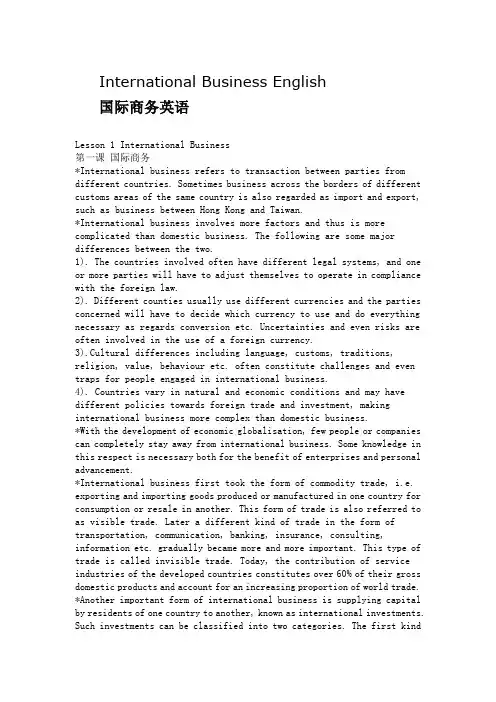
International Business English国际商务英语Lesson 1 International Business第一课国际商务*International business refers to transaction between parties from different countries. Sometimes business across the borders of different customs areas of the same country is also regarded as import and export, such as business between Hong Kong and Taiwan.*International business involves more factors and thus is more complicated than domestic business. The following are some major differences between the two.1). The countries involved often have different legal systems, and one or more parties will have to adjust themselves to operate in compliance with the foreign law.2). Different counties usually use different currencies and the parties concerned will have to decide which currency to use and do everything necessary as regards conversion etc. Uncertainties and even risks are often involved in the use of a foreign currency.3).Cultural differences including language, customs, traditions, religion, value, behaviour etc. often constitute challenges and even traps for people engaged in international business.4). Countries vary in natural and economic conditions and may have different policies towards foreign trade and investment, making international business more complex than domestic business.*With the development of economic globalisation, few people or companies can completely stay away from international business. Some knowledge in this respect is necessary both for the benefit of enterprises and personal advancement.*International business first took the form of commodity trade, i.e. exporting and importing goods produced or manufactured in one country for consumption or resale in another. This form of trade is also referred to as visible trade. Later a different kind of trade in the form of transportation, communication, banking, insurance, consulting, information etc. gradually became more and more important. This type of trade is called invisible trade. Today, the contribution of service industries of the developed countries constitutes over 60% of their gross domestic products and account for an increasing proportion of world trade. *Another important form of international business is supplying capital by residents of one country to another, known as international investments. Such investments can be classified into two categories. The first kindof investments, foreign direct investments or FDI for short is made for returns through controlling the enterprises or assets invested in in a host country.*The host country is a foreign country where the investor operates, while the country where the headquarters of the investor is located is called the home country. The second kind of investment, portfolio investment, refers to purchases of foreign financial assets for a purpose other than controlling. Such financial assets may be stocks, bonds or certificates of deposit.Stocks are also called capital stocks or bonds. Bonds are papers issued by a government or a firm with promise to pay back the money lent or invested together with interest. The maturity period of a bond is at least one year, often longer, for example five, or even ten years. Certificates of deposit generally involve large amounts, say 25 thousand US dollars *Besides trade and investment, international licensing and franchising are sometimes taken as a means of entering a foreign market. In licensing, a firm leases the right to use its intellectual property to a firm in another country. Such intellectual property may be trademarks, brand names, patents, copyrights or technology. Firms choose licensing because they do not have to make cash payments to start business, and can simply receive income in the form of royaltyBesides, they can benefit from locational advantages of foreign operation without any obligations in ownership or management. The use of licensing is particularly encouraged by high customs duty and non-tariff barriers on the part of the host country. However it is not advisable to use licensing in countries with weak intellectual property protection since the licensor may have difficulty in enforcing licensing agreement.*Franchising can be regarded as a special form of licensing. Under franchising, a firm, called the franchisee, is allowed to operate in the name of another, called the franchiser who provides the former with trademarks, brand names, logos, and operating techniques for royalty. In comparison with the relation between the licenser and the licensee, the franchiser has more control over and provides more support for the franchisee.*The franchiser can develop internationally and gain access to useful information about the local market with little risk and cost, and the franchisee can easily get into a business with established products or services. Franchising is fairly popular especially in hotel and restaurant business.*Other forms for participating in international business are management contract, contract manufacturing, and turnkey project.*Under a management contract, one company offers managerial or other specialized services to another within a particular period for a flat payment or a percentage of the relevant business volume. Sometimes bonusesbased on profitability or sales growth are also specified in management contracts.Government policies often have a lot to do with management contracts. When a government forbids foreign ownership in certain industries it considers to be of strategic importance but lacks the expertise for operation, management contracts may be a practical choice enabling a foreign company to operate in the industry without owning the assets*By contract manufacturing, a firm can concentrate on their strongest part in the value chain, e.g. marketing, while contracting with foreign companies for the manufacture of their products. Such firms can reduce the amount of their resources devoted to manufacture and benefit from location advantages from production in host countries. However, loss of control over the production process may give rise to problems in respect of quality and time of delivery.*For an international turnkey project, a firm signs a contract with a foreign purchaser and undertakes all the designing, contracting and facility equipping before handing it over to the latter upon completion. Such projects are often large and complex and take a long period to complete. Payment for a turnkey project may be made at fixed total price or on a cost plus basis. The latter way of payment shifts the burden of possible additional cost over the original budget onto the purchaser *BOT is a popular variant of the turnkey project where B stands for Build, O for operate and T for transfer. For a BOT project, a firm operate a facility for a period of time after building it up before finally transferring it to a foreign company. Making profit from operating the project for a period is the major difference between BOT and the common turnkey project. Needless to say, the contractor has to bear the financial and other risks that may occur in the period of operation.*Some Words and Expressionscustoms area 关税区in compliance with 遵从,遵照conversion n.货币兑换visible trade 有形贸易resale n.转售invisible trade 无形贸易gross domestic product 国内生产总值for short 缩写为account for 占……比例headquarters n.总部trap n.陷阱,圈套portfolio investment 证券投资stocks n.股票bonds n.债券maturity n.(票据等)到期,到期日certificate of deposit 大额存单other than 而不是licensing n.许可经营franchising n.特许经营n.商标advisable adj.可行的,适当的patent n.专利royalty n.专利使用费,许可使用费,版税copyright n.版权licensor n.给予许可的人licensee n.接受许可的人franchiser n.给予特许的人franchisee n.接受特许的人logo n.标识,标记management contract 管理合同expertise n.专门知识bonus n.红利,奖金,津贴flat adj.一律的,无变动的contract manufacturing 承包生产value chain 价值链turnkey project 交钥匙工程BOT(Build, Operate, Transfer)建设,经营,移交Stand for 表示,代表variant n.变形,变体Lesson twoIncome Level and the World Market第二课收入水平和世界市场This lesson discusses the relation between the income level and the market potential, and the features of high income, middle income and low income markets.Special analyses are made on Triad, i.e. the markets of North America,European Union and Japan, as well as other markets that are closely related with China.The first two paragraphs mainly deal with GNP and GDP, two important concepts usedto indicate the total size of an economy. GDP, Gross Domestic Product, stresses the place of production while GNP, Gross National Product, on the ownership of production factors.GDP is used by most countries now where as GNP was more popular before the 1990s. The actual figures of a country’s GNP and GDP are, however, quite similar in most cases and we can use whichever figure that is available.TEXT:In assessing the potential of a market, people often look at its income level since it provides clues about the purchasing power of its residents. The concepts national income and national product have roughly the same value and can be used interchangeably if our interest is in their sum total which is measured as the market value of the total output of goods and services of an economy in a given period, usually a year. The differenceis only in their emphasis. The former stresses the income generated by turning out the products while the latter, the value of the product s themselves. Gross National Product, GNP, and Gross Domestic Product, GDP, are two important concepts used to indicate a country’s total income. GNP refers to the market value of goods and services produced by the property and labor owned by the residents of an economy. This term was used by most governments before the 1990s国民生产总值(GNP)是最重要的宏观经济指标,它是指一个国家地区的国民经济在一定时期(一般1年)内以货币表现的全部最终产品(含货物和服务)价值的总和。

新标准商务英语综合教程1第二课课件全文共3篇示例,供读者参考篇1Title: New Standard Business English Comprehensive Course 1 Lesson 2 SlidesIntroduction:The New Standard Business English Comprehensive Course 1 is designed to help learners improve their English language skills in a business context. This course has been carefully crafted to provide practical and relevant content that will help learners communicate effectively in a variety of business situations. In this document, we will explore the key points covered in Lesson 2 of the course, as presented in the course slides.Lesson 2 Overview:Lesson 2 focuses on Communication Skills, covering topics such as effective communication strategies, the importance of listening, and how to communicate assertively in a business setting. The lesson also delves into the nuances of non-verbal communication and the role it plays in conveying messages accurately.Key Points from the Slides:1. Effective Communication Strategies: The slides emphasize the importance of clarity, brevity, and relevance in communication. Using examples and practical tips, learners are encouraged to structure their messages carefully to ensure they are understood by the intended audience.2. The Importance of Listening: Lesson 2 highlights the importance of active listening in effective communication. Learners are guided on how to be attentive, ask clarifying questions, and provide feedback to demonstrate understanding.3. Assertive Communication: The slides discuss the differences between passive, aggressive, and assertive communication styles. Learners are encouraged to practice assertiveness by expressing their opinions while respecting others' viewpoints.4. Non-Verbal Communication: The lesson covers the role of body language, facial expressions, and tone of voice in communication. Learners are taught how to interpret non-verbal cues and use them effectively to enhance their messages.Conclusion:Lesson 2 of the New Standard Business English Comprehensive Course 1 provides learners with valuable insights and practical tools to improve their communication skills in a business context. By mastering the key points covered in the slides, learners can enhance their ability to communicate effectively, build strong relationships, and succeed in their careers.篇2New Standard Business English Comprehensive Course 1 Lesson 2In this lesson, we will focus on the basics of business communication in English. Whether you are in a face-to-face meeting, writing an email, or giving a presentation, effective communication is crucial in the business world.1. Meeting Etiquette- When entering a meeting room, always greet everyone present with a firm handshake and a smile.- Address people by their title and last name unless you have been invited to use their first names.- Pay attention to cultural differences in communication styles and customs.2. Writing Emails- Keep emails concise and to the point. Avoid unnecessary details.- Use a professional tone and grammar in your emails.- Always proofread your emails before sending them.3. Giving Presentations- Structure your presentation with a clear introduction, body, and conclusion.- Use visuals such as charts and graphs to support your points.- Practice your presentation beforehand to ensure a smooth delivery.4. Business Vocabulary- Familiarize yourself with common business terms and phrases such as "profit margin," "market share," and "competitive advantage."- Use vocabulary appropriate to the context of your communication.5. Negotiation Skills- Be prepared for negotiations by knowing your goals and limits.- Listen actively to the other party and offer compromises when necessary.- Maintain professionalism and composure during negotiations.6. Role-playing Exercises- Practice your communication skills through role-playing scenarios such as sales pitches, negotiations, and conflict resolution.- Solicit feedback from peers and instructors to improve your communication skills.By mastering the basics of business communication in English, you will be better equipped to succeed in the global business environment. Remember to practice regularly and seek opportunities to improve your skills. Good luck on your journey to becoming a proficient business English communicator!篇3Title: A Review of New Standard Business English Comprehensive Course 1 Lesson 2 PowerPointIntroductionThe New Standard Business English Comprehensive Course 1 Lesson 2 PowerPoint is an essential tool for teaching and learning business English. The PowerPoint is designed to help students understand and practice the key concepts of the lesson in a visual and interactive way. In this review, we will explore the key features of the PowerPoint and its effectiveness in enhancing students' learning experience.Key Features of the PowerPoint1. Clear and Engaging Layout: The PowerPoint features a clear and engaging layout with a professional design that is visually appealing to students. The use of colors, images, and graphics helps to capture students' attention and maintain their interest throughout the lesson.2. Comprehensive Content: The PowerPoint covers all the key topics and vocabulary introduced in Lesson 2 of the New Standard Business English Comprehensive Course 1. The contentis presented in a clear and organized manner, making it easy for students to follow along and understand the material.3. Interactive Activities: The PowerPoint includes interactive activities such as matching exercises, multiple-choice quizzes, and role-playing scenarios. These activities help students practice and reinforce their understanding of the lesson material in a fun and engaging way.4. Audio and Video Clips: The PowerPoint features audio and video clips of native English speakers, helping students improve their listening and pronunciation skills. The clips are authentic and relevant to the lesson content, providing students with real-world examples of business English communication.Effectiveness of the PowerPointThe New Standard Business English Comprehensive Course 1 Lesson 2 PowerPoint is highly effective in enhancing students' learning experience. The visual and interactive nature of the PowerPoint helps to engage students and keep them motivated throughout the lesson. The comprehensive content and interactive activities help students practice and apply their knowledge of business English in a meaningful way.Furthermore, the audio and video clips included in the PowerPoint provide students with valuable listening and speaking practice, helping them improve their communication skills in a business context. Overall, the PowerPoint serves as a valuable tool for both teachers and students in teaching and learning business English effectively.ConclusionIn conclusion, the New Standard Business English Comprehensive Course 1 Lesson 2 PowerPoint is an essential resource for teaching and learning business English. Its clear and engaging layout, comprehensive content, interactive activities, and audio and video clips make it a highly effective tool for enhancing students' learning experience. By using the PowerPoint, teachers can effectively teach key concepts and vocabulary, while students can practice and improve their business English skills in a dynamic and engaging way.。
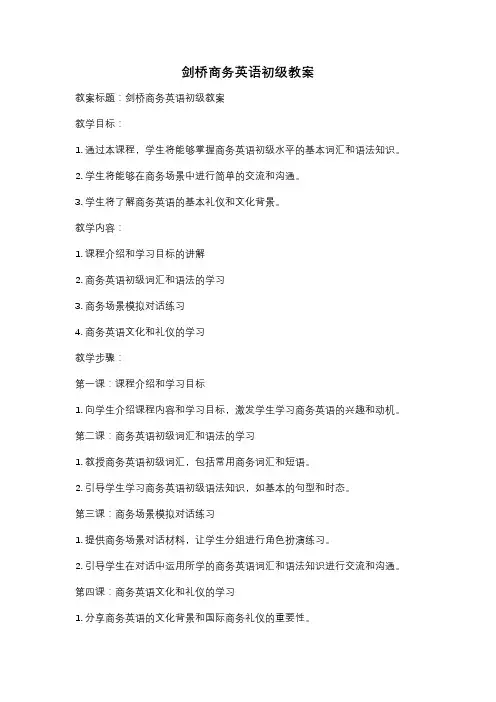
剑桥商务英语初级教案教案标题:剑桥商务英语初级教案教学目标:1. 通过本课程,学生将能够掌握商务英语初级水平的基本词汇和语法知识。
2. 学生将能够在商务场景中进行简单的交流和沟通。
3. 学生将了解商务英语的基本礼仪和文化背景。
教学内容:1. 课程介绍和学习目标的讲解2. 商务英语初级词汇和语法的学习3. 商务场景模拟对话练习4. 商务英语文化和礼仪的学习教学步骤:第一课:课程介绍和学习目标1. 向学生介绍课程内容和学习目标,激发学生学习商务英语的兴趣和动机。
第二课:商务英语初级词汇和语法的学习1. 教授商务英语初级词汇,包括常用商务词汇和短语。
2. 引导学生学习商务英语初级语法知识,如基本的句型和时态。
第三课:商务场景模拟对话练习1. 提供商务场景对话材料,让学生分组进行角色扮演练习。
2. 引导学生在对话中运用所学的商务英语词汇和语法知识进行交流和沟通。
第四课:商务英语文化和礼仪的学习1. 分享商务英语的文化背景和国际商务礼仪的重要性。
2. 讨论不同文化背景下的商务交流差异,并提供实际案例进行分析和讨论。
教学评估:1. 通过课堂练习和角色扮演,评估学生对商务英语词汇和语法的掌握程度。
2. 通过小组讨论和案例分析,评估学生对商务英语文化和礼仪的理解和应用能力。
教学资源:1. 剑桥商务英语初级教材和练习册2. 商务英语词汇和语法练习题3. 商务场景对话材料和角色扮演指导4. 商务英语文化和礼仪案例分析材料教学反思:1. 根据学生的学习情况和反馈,及时调整教学内容和方法,提供个性化的辅导和指导。
2. 鼓励学生自主学习和实践,提供额外的学习资源和练习材料。

LESSON 2Talking About Your JobWhat Do You Think?ABC Manager is talking to the newly hired employees explaining their job duties and responsibilities. What do you think is their job? Explain their duties and responsibilities.Let’s Try It!Read the dialogue with correct intonation and stress.Jack: Hi Peter. Can you tell me a little bit about your current job?Peter: Certainly what would you like to know?Jack: First of all, what do you work as?Peter: I work as a computer technician at Schuller's and Co.Jack: What do your responsibilities include?Peter: I'm responsible for systems administration and in‐house programming.Jack: What sort of problems do you deal with on a day‐to‐day basis?Peter: Oh, there are always lots of small system glitches. I also provide information on a need‐to‐know basis for employees.Jack: What else does your job involve?Peter: Well, as I said, for part of my job I have to develop in‐house programs for special company tasks.Jack: Do you have to produce any reports?Peter: No, I just have to make sure that everything is in good working order.Jack: Do you ever attend meetings?Peter: Yes, I attend organizational meetings at the end of the month.Jack: Thanks for all the information, Peter. It sounds like you have an interesting job. Peter: Yes, it's very interesting, but stressful, too!It’s Your Turn!Try to give your opinion on the following situation:Please explain in details your duties and responsibilities in your current job.Useful Vocabulary:Computer technicianday‐to‐day basisglitchgood working orderin‐houseneed‐to‐know basisgood working orderOrganizational meetingStressful。
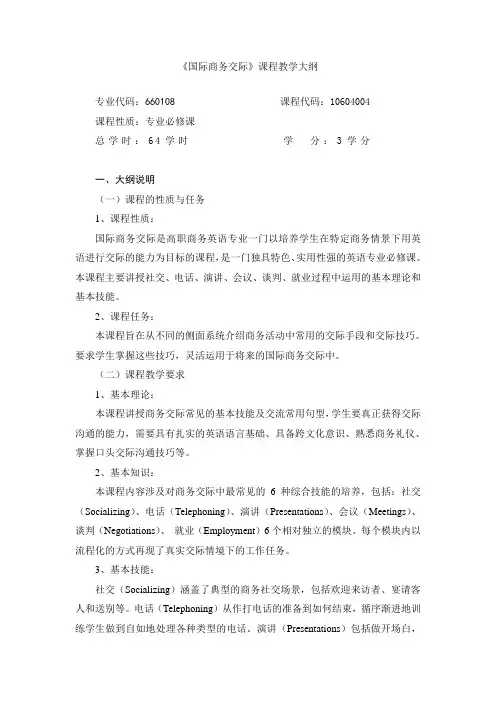
《国际商务交际》课程教学大纲专业代码:660108课程代码:10604004课程性质:专业必修课总学时:64学时学分:3学分一、大纲说明(一)课程的性质与任务1、课程性质:国际商务交际是高职商务英语专业一门以培养学生在特定商务情景下用英语进行交际的能力为目标的课程,是一门独具特色、实用性强的英语专业必修课。
本课程主要讲授社交、电话、演讲、会议、谈判、就业过程中运用的基本理论和基本技能。
2、课程任务:本课程旨在从不同的侧面系统介绍商务活动中常用的交际手段和交际技巧。
要求学生掌握这些技巧,灵活运用于将来的国际商务交际中。
(二)课程教学要求1、基本理论:本课程讲授商务交际常见的基本技能及交流常用句型,学生要真正获得交际沟通的能力,需要具有扎实的英语语言基础、具备跨文化意识、熟悉商务礼仪、掌握口头交际沟通技巧等。
2、基本知识:本课程内容涉及对商务交际中最常见的6种综合技能的培养,包括:社交(Socializing)、电话(Telephoning)、演讲(Presentations)、会议(Meetings)、谈判(Negotiations)、就业(Employment)6个相对独立的模块。
每个模块内以流程化的方式再现了真实交际情境下的工作任务。
3、基本技能:社交(Socializing)涵盖了典型的商务社交场景,包括欢迎来访者、宴请客人和送别等。
电话(Telephoning)从作打电话的准备到如何结束,循序渐进地训练学生做到自如地处理各种类型的电话。
演讲(Presentations)包括做开场白,运用肢体语言,运用演示工具,结束演讲等内容。
会议(Meeting)涉及召集会议,开始会议,控制会议,打断对方发言以及撰写会议议程及会议记录。
谈判(Negotiations)涉及准备,开始进行谈判,陈述观点,解决争端和迫使对方妥协等内容。
求职(Employment Communication)包括分析自我,分析市场,获取就业信息,准备简历到最后的面试成功等内容。


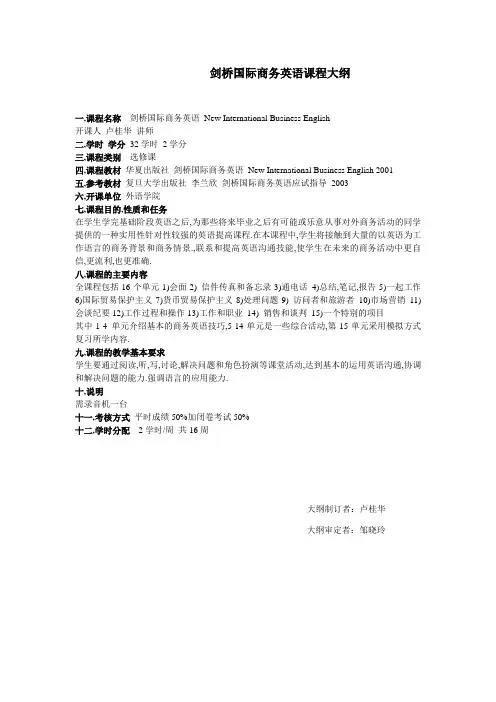
剑桥国际商务英语课程大纲一,课程名称剑桥国际商务英语New International Business English开课人卢桂华讲师二,学时学分32学时2学分三,课程类别选修课四,课程教材华夏出版社剑桥国际商务英语New International Business English 2001五,参考教材复旦大学出版社李兰欣剑桥国际商务英语应试指导2003六,开课单位外语学院七,课程目的,性质和任务在学生学完基础阶段英语之后,为那些将来毕业之后有可能或乐意从事对外商务活动的同学提供的一种实用性针对性较强的英语提高课程.在本课程中,学生将接触到大量的以英语为工作语言的商务背景和商务情景.,联系和提高英语沟通技能,使学生在未来的商务活动中更自信,更流利,也更准确.八,课程的主要内容全课程包括16个单元1)会面2) 信件传真和备忘录3)通电话4)总结,笔记,报告5)一起工作6)国际贸易保护主义7)货币贸易保护主义8)处理问题9) 访问者和旅游者10)市场营销11)会谈纪要12)工作过程和操作13)工作和职业14) 销售和谈判15)一个特别的项目其中1-4 单元介绍基本的商务英语技巧,5-14单元是一些综合活动,第15单元采用模拟方式复习所学内容.九,课程的教学基本要求学生要通过阅读,听,写,讨论,解决问题和角色扮演等课堂活动,达到基本的运用英语沟通,协调和解决问题的能力.强调语言的应用能力.十,说明需录音机一台十一,考核方式平时成绩50%加闭卷考试50%十二,学时分配2学时/周共16周大纲制订者:卢桂华大纲审定者:邹晓玲剑桥国际商务英语1 课程中文名称剑桥国际商务英语New International Business English开课人卢桂华讲师2 学时学分32学时2学分3 课程类别选修课4 预修课程大学英语5内容简介全课程包括16个单元1)会面2) 信件传真和备忘录3)通电话4)总结,笔记,报告5)一起工作6)国际贸易保护主义7)货币贸易保护主义8)处理问题9) 访问者和旅游者10)市场营销11)会谈纪要12)工作过程和操作13)工作和职业14) 销售和谈判15)一个特别的项目其中1-4 单元介绍基本的商务英语技巧,5-14单元是一些综合活动,第15单元采用模拟方式复习所学内容.学生要通过阅读,听,写,讨论,解决问题和角色扮演等课堂活动,达到基本的运用英语沟通,协调和解决问题的能力.强调语言的应用能力.6 课程教材剑桥国际商务英语New International Business English华夏出版社20017 参考书复旦大学出版社李兰欣剑桥国际商务英语应试指导20038 选课对象已通过英语四级的本科生研究生9 开课单位外语学院商务英语阅读课程教学大纲一、课程名称:《商务英语阅读》(English Readings in International Business)课程负责人:朱万忠二、学时与学分:32学时2学分三、课程类别:文化素质教育选修课四、课程教材:陈苏东,陈建平主编,《商务英语阅读》,北京:高等教育出版社,2002五、参考教材:熊伟编著, 《国际贸易实务英语》,武汉:武汉大学出版社,2001六、开课单位:重庆大学外国语学院七、课程的目的、性质和任务“商务英语阅读”使实用性很强的课程,以西方报刊中报到和论述国际商务的文章为主要内容,集英语语言学习和国际商务知识的传授为一体,通过有指导的阅读和训练,使学生掌握这类文章的文体、语言和内容特点,提高语言理解和欣赏能力,培养学生收集、整理和研究国际商务信息的能力,锻炼其逻辑思维能力,扩大其国际商务背景知识。
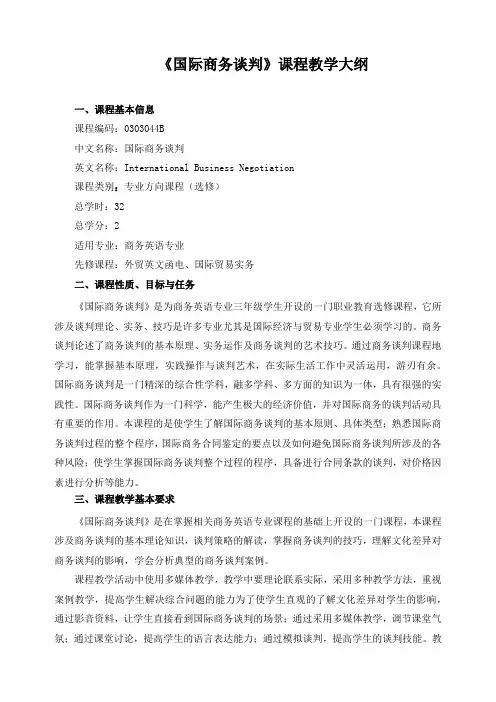
《国际商务谈判》课程教学大纲一、课程基本信息课程编码:0303044B中文名称:国际商务谈判英文名称:International Business Negotiation课程类别:专业方向课程(选修)总学时:32总学分:2适用专业:商务英语专业先修课程:外贸英文函电、国际贸易实务二、课程性质、目标与任务《国际商务谈判》是为商务英语专业三年级学生开设的一门职业教育选修课程,它所涉及谈判理论、实务、技巧是许多专业尤其是国际经济与贸易专业学生必须学习的。
商务谈判论述了商务谈判的基本原理、实务运作及商务谈判的艺术技巧。
通过商务谈判课程地学习,能掌握基本原理,实践操作与谈判艺术,在实际生活工作中灵活运用,游刃有余。
国际商务谈判是一门精深的综合性学科,融多学科、多方面的知识为一体,具有很强的实践性。
国际商务谈判作为一门科学,能产生极大的经济价值,并对国际商务的谈判活动具有重要的作用。
本课程的是使学生了解国际商务谈判的基本原则、具体类型;熟悉国际商务谈判过程的整个程序,国际商务合同鉴定的要点以及如何避免国际商务谈判所涉及的各种风险;使学生掌握国际商务谈判整个过程的程序,具备进行合同条款的谈判,对价格因素进行分析等能力。
三、课程教学基本要求《国际商务谈判》是在掌握相关商务英语专业课程的基础上开设的一门课程,本课程涉及商务谈判的基本理论知识,谈判策略的解读,掌握商务谈判的技巧,理解文化差异对商务谈判的影响,学会分析典型的商务谈判案例。
课程教学活动中使用多媒体教学,教学中要理论联系实际,采用多种教学方法,重视案例教学,提高学生解决综合问题的能力为了使学生直观的了解文化差异对学生的影响,通过影音资料,让学生直接看到国际商务谈判的场景;通过采用多媒体教学,调节课堂气氛;通过课堂讨论,提高学生的语言表达能力;通过模拟谈判,提高学生的谈判技能。
教学中,通过课堂讨论、案例分析提高学生语言表达能力的培养,采取灵活多边的教学方法和模式,增加讨论分析课时。

Lesson 2 Income Level and the World MarketIn assessing the potential of a market, people often look at its income level since it provides clues about the purchasing power of its residents. The concepts national income and national product have roughly the same value and can be used interchangeably if our interest is in their sum total which is measured as the market value of the total output of goods and services of an economy in a given period, usually a year. The difference is only in their emphasis. The former stresses the income generated by turning out the products while the latter, the value of the products themselves. GNP (Gross National Product) and GDP (Gross Domestic Product) are two important concepts used to indicate a country’s total income. GNP refers to the market value of goods and services produced by the property and labor owned by the residents of an economy. This term was used by most governments before the 1990s. GDP measures the market value of all goods and services produced within the geographic area of an economy. It has been preferred by most countries since the 1990s.The difference between GNP and GDP is that the former focuses on ownership of the factors of production while the latter concentrates on the place where production takes place. For example, the dividend returned by the subsidiary of Microsoft in China is included in the US GNP but not in its GDP. And the production of the same subsidiary is included in China’s GDP but not in its GNP. The difference between GNP and GDP can be ignored since it is very small in most cases. People can use whichever term that is more easily available and they can compare a country’s GNP and another country’s GDP without worrying that the result would be terribly distorted. For instance, in 1996, the US GNP was 7637.7 billion US dollars and its GDP was 7636 billion US Dollars, a difference of only 0.02%. And in 1999, China’s GNP was 8042.28 billion yuan Reminbi and its GDP was 8191.09 billion yuan, with a difference of 1.8%, still insignificant though larger than the US figure.In assessing the potential of a country as a market, people often look at per capita income. Similar to the case of national income and national product, per capita income and per capita GDP do not have much difference. So let’s use per capita GDP to illustrate an economy’s income level. It is calculated by dividing its total GDP by its population. Total GDP indicates the overall size of an economy, which is important in market assessment for durable equipment or bulk goods such as grain, steel, or cement. Per capita GDP reveals the average income level of consumers, which is important then marketing consumer durables. For example, China has a large GDP of roughly USD 1.4 trillion in 2003, being the seventh largest economy in the world. If adjusted by PPP, the figure would probably be as large as USD 6.4 trillion, accounting for 12% of the world’s total and ranking the second only after the USA. So China is not only a newly emerging producer but also an important newly emerging market. However its per capita GDP is still fairly low, just a bit over USD 1100. Though $1000 per capita income is believed by experts to be the level at which consumerism begins to emerge, the Chinese figure is still rather low, ranking only the 111th in the world. In contrast, Singapore has a GDP of roughly a bit over$ 100 billion, but a per capita income as high as $ 32 810. Obviously China andSingapore represent two different kinds of markets.Business people are also concerned about the income distribution of a market, i.e. the proportions of its rich, middle income and poor people. Producers of quality electrical appliances such as color TVs are interested in the size of a country’s middle class, while manufacturers of expensive cars such as Rolls-Royces may want to know the number of its millionaires.Countries of the world are divided by the World Bank into three categories of high income, middle income and low income economies. Those enjoying annual per capita income of $9386 and above are classified as high income countries. This group comprises three types of countries. The first type includes most members of the organization for economic cooperation and development (OECD). The second type are rich oil producing countries of the middle east such as Kuwait, Saudi Arabia, and the united Arab emirates. The third type consists of small industrialized countries or regions such as Israel, Singapore, Hong Kong and Taiwan. High income countries often have good infrastructure, high purchasing power, advanced technology, efficient management, and favorable environment for trade and investment. They often prime markets for expensive consumer goods and are both attractive sources and destinations of investment.Countries with annual per capita income below $9386 but above $765 are regarded as middle income countries. Included in this category are most east European countries and most members of the commonwealth of independent states, six OECD members are not up to the level of high income countries (Czech, Greece, Hungary, Mexico, and turkey), quite a number of Latin American countries and some comparatively developed countries in Asia, such as Indonesia, Malaysia, the Philippines, and Thailand. Among the African countries, South Africa and oil producing Libya, Nigeria and Algeria belong to this category. China with a per capita income of over $1100 is a middle income country though it was a low income country just a few years ago.Lower income countries are those that have per capita incomes of only $765 or even less. Most African countries, some Asian countries and a few Latin American countries are included in this group. These countries usually have poor infrastructure, low consumer demand and unfavorable business environment. But that does not mean they should be neglected in international business activities, because they constitute markets for lower priced staple goods, provide cheap labor and are often rich in resources. What is more important, market is something to be developed. Once tapped, the business potential of these countries will one day become real business opportunities.The term Triad refers to the three richest regions of the world the united stated, the European Union and Japan that offer the most important business opportunities. Any international enterprise must bear Triad in mind if they want to be successful in the increasingly competitive world market.With a per capita income of about $30000, the United States is the richest country in the western hemisphere. Though the per capita income of a few small countries like Switzerland is much higher than that of the United States, the overall size of the US economy of about $10 trillion GDP, roughly a quarter of the world total, coupled with its political stability puts the country on a unique position in the world. It accounts for about 15% of world visible and invisible trade. The US dollar is the invoicing currency for about half of the international transactions and is an important component of foreign currency reserves of the world. The United States has been regarded by many people as a safe haven who tend to keep their wealth in US dollar when they lose confidence in the value of their own currency. And for many years the country remained the largest recipient of foreign investment. Over 160 of the world’s 500 largest corporations have their headquarters inthe United States including 24 of the top 100. The country’s large middle classes make it an attractive market for enterprises all around the globe.The second component of Triad is Western Europe that mainly refers to the European Union. With an average per capita income of over $20000, all the members before its eastward expansion are classified as high income countries. Its total GDP of over 10 trillion US dollars is the largest, larger than that of the United States. Germany, France, Britain and Italy are the four richest, most populous and developed countries of EU. These countries are each an attractive market, and combined they constitute the largest rich market in the world. In the present intensely competing world, it is necessary and beneficial to diversify our major markets, and the importance of EU as on leg of Triad cannot be over-stressed.Japan is the third component of Triad and the second largest economy of the world. It is an important supplier of high tech products and a major importer of raw materials. While exports have greatly spurred Japan’s development, trade only accounts for a relatively small proportion of its GDP. Japan remained a target of criticism for engaging in unfair trade practices. The large trade surplus has enabled it to invest heavily abroad and for years it has been the largest creditor country of the world. With mutually complementary economy, Japan and china are major trade partners, and the two countries are close neighbours separated only by a strip of water. Sino-Japanese business relations are therefore of great importance to both countries.Some people extend the scope of Triad to include Canada and name the broadened grouping Quad. With the world’s second largest territory, Canada is rich in natural resources and its export accounts for nearly 40% of its GDP. The percentage is much higher than those of other members of the Group of Seven and suffices to show the importance of trade to the country. Sharing a very long common border along which most of the Canadian people live, Canada and the United States, with their respective rich market, enjoy the largest single bilateral trade in the world.So far as China is concerned, other markets we should pay particular attention to are those around us: the Four Tigers, the ASEAN countries, Russia, India, and a bit fartheraway Australia. These countries or regions either have rich consumers and offer good business opportunities or are developing fast with very promising market potential. And their geographical proximity to China is a great advantage for us in developing business relations with them.Despite the above observations, it does not mean we can neglect other markets. Different markets offer different opportunities and it is not a good idea to tie one’s business to only a few markets. The best policy is to develop business opportunities wherever advantageous while keeping in mind the key markets.。